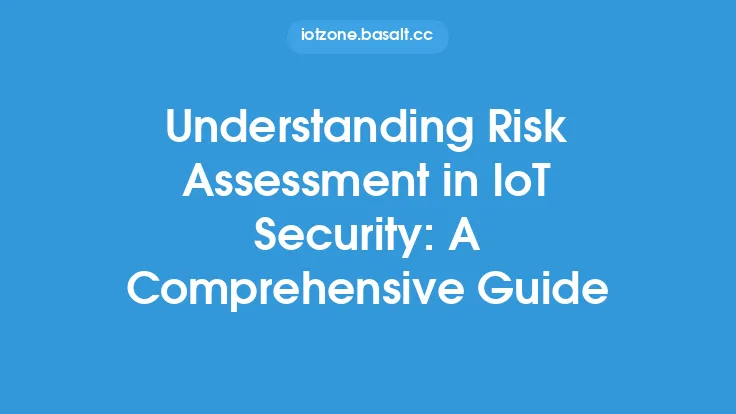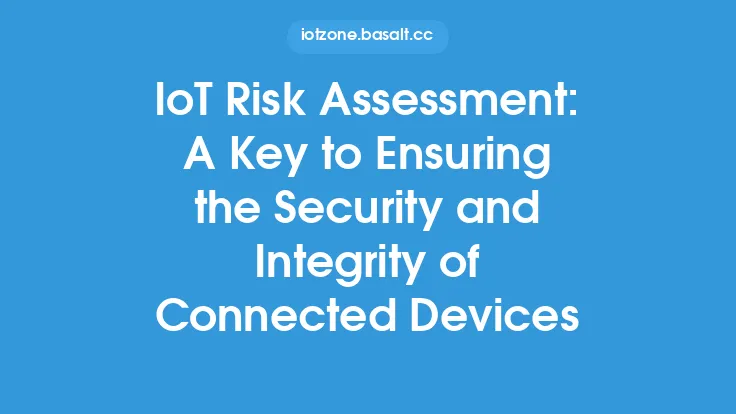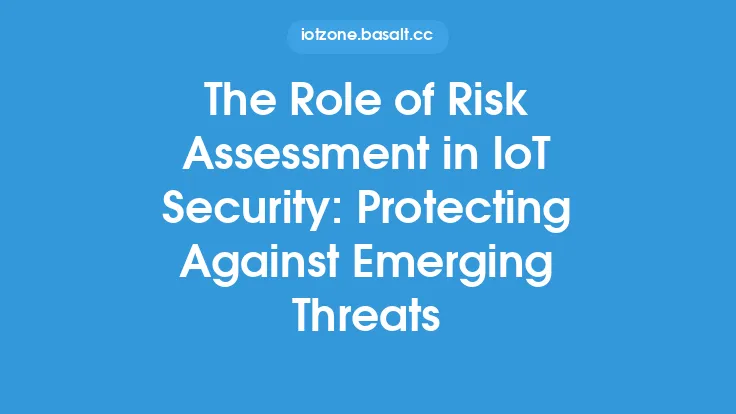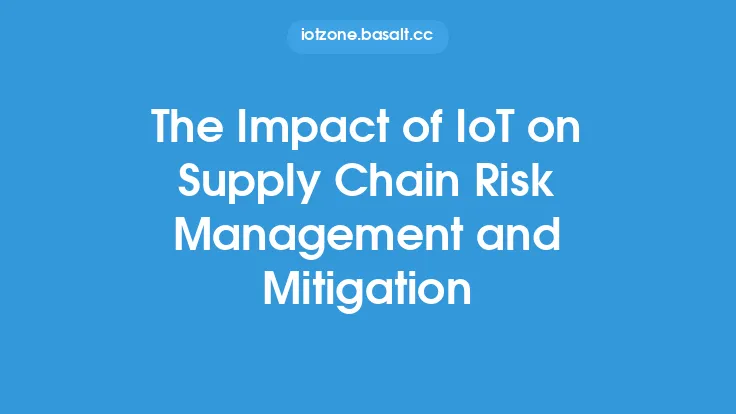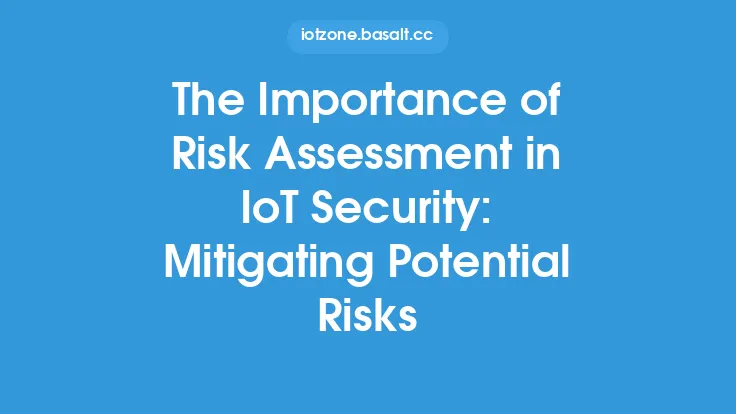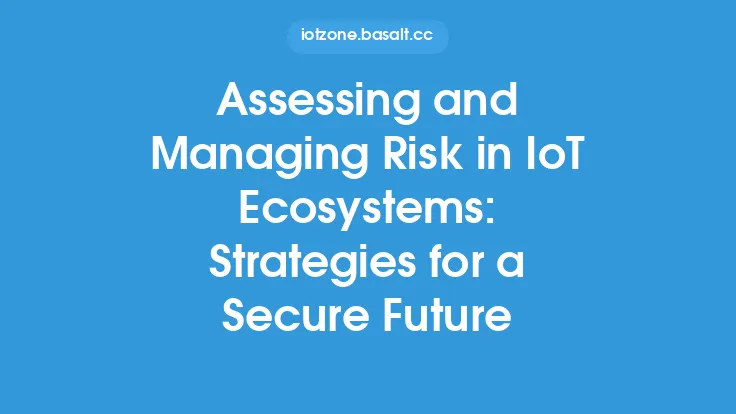The increasing number of connected devices in the Internet of Things (IoT) has created a vast attack surface, making it essential to implement a comprehensive security strategy that includes risk assessment and management. IoT risk assessment and management involve identifying, evaluating, and mitigating potential risks associated with IoT devices, networks, and systems. This critical component of IoT security helps organizations to protect their devices, data, and users from various threats, including unauthorized access, data breaches, and malware attacks.
Introduction to IoT Risk Assessment
IoT risk assessment is a systematic process that helps organizations to identify and evaluate potential risks associated with their IoT devices and systems. It involves analyzing the likelihood and potential impact of various threats, including device compromise, data breaches, and network attacks. The goal of IoT risk assessment is to identify vulnerabilities and weaknesses in the IoT ecosystem and prioritize mitigation efforts to minimize the risk of a security breach. IoT risk assessment should be an ongoing process, as new threats and vulnerabilities emerge continuously, and the IoT ecosystem is constantly evolving.
Key Components of IoT Risk Assessment
IoT risk assessment involves several key components, including:
- Device Assessment: Evaluating the security features and vulnerabilities of individual IoT devices, including their hardware, software, and firmware.
- Network Assessment: Analyzing the security of the network infrastructure that connects IoT devices, including routers, switches, and firewalls.
- System Assessment: Evaluating the security of the overall IoT system, including its architecture, data flows, and user interactions.
- Threat Assessment: Identifying potential threats to the IoT ecosystem, including device compromise, data breaches, and network attacks.
- Vulnerability Assessment: Identifying vulnerabilities in IoT devices, networks, and systems that could be exploited by attackers.
Risk Management Strategies for IoT
Effective risk management is critical to mitigating the risks associated with IoT devices and systems. The following risk management strategies can help organizations to minimize the risk of a security breach:
- Device Security: Implementing security measures such as encryption, secure boot mechanisms, and secure firmware updates to protect IoT devices from compromise.
- Network Security: Implementing security measures such as firewalls, intrusion detection systems, and secure network protocols to protect the network infrastructure.
- System Security: Implementing security measures such as access controls, authentication mechanisms, and secure data storage to protect the overall IoT system.
- Incident Response: Developing an incident response plan to quickly respond to security breaches and minimize their impact.
- Continuous Monitoring: Continuously monitoring the IoT ecosystem for potential security threats and vulnerabilities.
Technical Considerations for IoT Risk Assessment
IoT risk assessment requires a deep understanding of the technical aspects of IoT devices, networks, and systems. The following technical considerations should be taken into account:
- Device Communication Protocols: Understanding the communication protocols used by IoT devices, such as CoAP, MQTT, and HTTP, to identify potential vulnerabilities.
- Data Encryption: Evaluating the encryption mechanisms used to protect data transmitted by IoT devices, such as SSL/TLS and AES.
- Firmware Updates: Assessing the firmware update mechanisms used by IoT devices to ensure that they are secure and reliable.
- Network Architecture: Analyzing the network architecture of the IoT ecosystem, including the use of segmentation, firewalls, and intrusion detection systems.
- Device Authentication: Evaluating the authentication mechanisms used by IoT devices, such as username/password and certificate-based authentication.
Best Practices for IoT Risk Assessment and Management
The following best practices can help organizations to conduct effective IoT risk assessments and manage risks:
- Conduct Regular Risk Assessments: Conducting regular risk assessments to identify and evaluate potential risks associated with IoT devices and systems.
- Implement Security Measures: Implementing security measures such as encryption, secure boot mechanisms, and secure firmware updates to protect IoT devices from compromise.
- Monitor the IoT Ecosystem: Continuously monitoring the IoT ecosystem for potential security threats and vulnerabilities.
- Develop an Incident Response Plan: Developing an incident response plan to quickly respond to security breaches and minimize their impact.
- Collaborate with Stakeholders: Collaborating with stakeholders, including device manufacturers, network operators, and users, to ensure that IoT risk assessment and management are effective and comprehensive.
Conclusion
IoT risk assessment and management are critical components of a comprehensive security strategy for IoT devices, networks, and systems. By identifying and evaluating potential risks, implementing risk management strategies, and following best practices, organizations can minimize the risk of a security breach and protect their devices, data, and users. As the IoT ecosystem continues to evolve, it is essential to stay informed about emerging threats and vulnerabilities and to continuously monitor and assess the security of IoT devices and systems.
